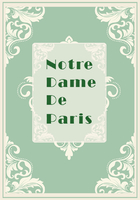
第72章 BOOK Ⅴ(9)
But when the sun of the Middle Ages has wholly set,when the radiance of Gothic genius has faded forever from the horizon of art,architecture,too,grows slowly pale,wan and lifeless.The printed book,that gnawing worm,sucks the life-blood from her and devours her.She droops,she withers,she wastes away before the eye.She becomes mean and poor,of no account,conveying nothing to the mind—not even the memory of the art of other days.Reduced to her own exertions,deserted by the other arts because human thought has left her in the lurch,she has to employ the artisan in default of the artist.Plain glass replaces the glowing church window,the stone-mason the sculptor;farewell to vital force,to originality,life or intelligence;as a lamentabie beggar of the studios she drags herself from copy to copy.Michael Angelo,doubtless sensible of her approaching end,made one last despairing effort in her aid.That Titan of the world of art piled the Pantheon on the Parthenon and so made Saint-Peter's of Rome—a gigantic work that deserved to remain unique,the last orginality of architecture,the signature of a mighty artist at the bottom of the colossal register of stone thus closed.But Michael Angelo once dead,what does this wretched architecture do,which only survives as a spectre,as a shade?She takes Saint-Peter's and copies,parodies it.It becomes a mania with her,a thing to weep at:in the seventeenth century the Val-de-Grace,in the eighteenth,Sainte-Geneviève.Every country has its Saint-Peter's.London has hers,St.Petersburg hers,Paris even two or three—a legacy of triviality,the last drivellings of a grand but decrepit art,fallen into second childhood before its final dissolution.
If,instead of the characteristic monuments like those of which we have spoken,we examine the general aspect of the art from the sixteenth to the eighteenth century,we shall find everywhere the same evidences of decrepitude and decay.From the time of Francis II the form of the edifice lets the geometrical outline show through more and more,like the bony framework through the skin of an emaciated body.The generous curves of art give place to the cold and inexorable lines of geometry.An edifice is no longer an edifice,it is a polyhedron.Architecture,however,is at infinite pains to cover her nakedness,and hence the Greek pediment set in the Roman pediment and vice versa.It is always the Pantheon on the Parthenon,Saint-Peter's at Rome.Such are the brick houses with stone corners of the time of Henri IV,the Place Royale,the Place Dauphine.Such are the churches of Louis XIII,heavy,squat,compressed,with a dome like a hump.Thus,too,is the Mazarin architecture,the poor Italian pasticcio of the Quatre-Nations,the palaces of Louis XIV,mere court barracks,endless,frigid,wearisome;and finally,the style of Louis XV with its chicory-leaf and vermicelli ornaments,and all the warts and growths disfiguring that aged,toothless,demoralized coquette.From Francis II to Louis XV the malady progressed in geometrical ratio.The art is reduced to skin and bone,her life ebbs miserably away.
Meanwhile,what of the art of printing?All the vital force taken from architecture streams to her.As architecture sinks,so printing rises and expands.The store of strength spent hitherto by human thought on edifices is now bestowed on books;till,by the sixteenth century,the press,grown now to the level of her shrunken rival,wrestles with her and prevails.In the seventeenth century she is already so absolute,so victorious,so firmly established on her throne,that she can afford to offer to the world the spectacle of a great literary era.In the eighteenth century,after long idleness at the Court of Louis XIV,she takes up again the ancient sword of Luther,thrusts it into Voltaire's hand,and runs full tilt at that antiquated Europe whom she has already robbed of all architectural expression.Thus,as the eighteenth century ends she has accomplished her work of destruction;with the nineteenth century she begins to construct.
Now which of these two arts,we ask,represents in truth the course of human thought during three centuries;which of the two transmits,expresses,not only its fleeting literary and scholastic fashion,but its vast,profound,all-embracing tendencies?Which of the two has fitted itself like a skin,without a crease or gap,over that thousand-footed,never-resting monster,the human race?Architecture or Printing?